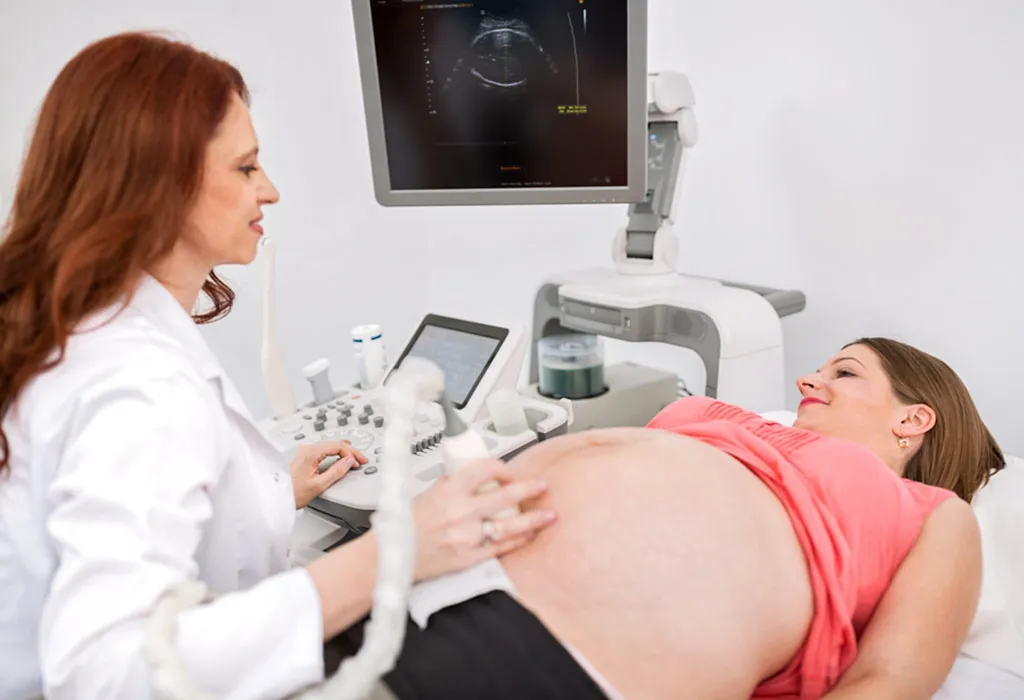NT (Nuchal Translucency) Scan in Pregnancy – Importance & Procedure

Congenital disorders or defects are defined as disorders or defects that babies are born with, or in simpler words – birth disorders or defects. Most of the time, congenital disorders cannot be treated. However, it definitely helps to know before the birth of your baby if he is going to have any congenital disorder. Pregnancy ultrasounds help ensure the appropriate growth and development of the baby. One such scan/test is the Nuchal Translucency (NT) Scan, which helps doctors diagnose if the baby is at risk of developing Down’s Syndrome. NT Scan in pregnancy is a promising technology for detecting potential abnormalities in an unborn baby. If your doctor suspects any unusual readings on your ultrasound, they may recommend Nuchal Translucency scanning. Read on to learn more about the Nuchal Translucency scan.
What Is Nuchal Translucency (NT) Scan?
The Nuchal Translucency (NT) Scan is a prenatal screening. It allows us to primarily determine if the baby runs a risk factor of being born with Down’s Syndrome (1). Down’s Syndrome is a congenital defect wherein a baby is born with three copies of chromosome number 21 (instead of the normal 2 copies) (2).
Along with this, the NT scan is also able to detect if your baby is at risk of having few other congenital defects like other chromosomal abnormalities (particularly in chromosome number 13 and 18), and heart problems.
Please Note :- The NT scan is only a ‘screening’ test. It cannot identify with 100% accuracy whether or not your baby will be born with Down’s Syndrome. It will only identify the degree of ‘risk’. In other words, the NT scan gives a probability of your baby developing Down’s Syndrome. Based on the results of the scan (which will be explained further in this article) your gynaecologist may advise you to take a ‘diagnostic’ test, which will tell you with certainty whether or not your baby will develop Down’s Syndrome.
Let’s now take a look at Nuchal Translucency a little more in-depth and also understand how the scan is done. We are aiming to answer all the questions you could possibly have about this topic. But, in case you have some more questions, you must speak to your gynaecologist immediately.
What Is Nuchal Translucency?
Nuchal translucency is the sonographic appearance of the degree of translucency of the fluid that builds up at the back of your baby’s neck (or the ‘nape’ of the neck) during his normal growth within the womb (3) (4). The fluid build-up is a normal process; however, the composition of this fluid, especially its thickness and translucency, is affected by chromosomal abnormalities, such as the one responsible for Down’s Syndrome.
Importance of Nuchal Translucency Scan
The NT test during pregnancy helps assess the probability of some chromosomal conditions but does not provide a diagnosis or treatment. It estimates the risk of (5):
- Down Syndrome (Trisomy 21): Caused by extra genetic material on chromosome 21, leading to distinct features, learning challenges, and possible congenital heart issues.
- Edward’s Syndrome (Trisomy 18): It is a rare genetic disorder that can cause severe organ abnormalities and developmental delays and also lead to a shortened life expectancy (6).
- Patau Syndrome (Trisomy 13): Similar in severity to Edward’s Syndrome, this condition results from an extra copy of chromosome 13, potentially causing structural defects, intellectual disabilities, and organ complications.
Beyond genetic risk assessment, the NT scan also checks fetal heart health and development, offering more insights into the baby’s overall well-being.
How Is the Nuchal Translucency (NT) Ultrasound Scan Carried Out?
An NT scan is nothing but sonography. It can be performed as a Transabdominal or Transvaginal Ultrasound. It is important to note that to measure the NT, the fetal crown-rump length should be between 45 mm and 84 mm (7).
1. Transabdominal Ultrasound
Here are the steps carried out for a transabdominal ultrasound.
- The sonographer applies some gel all over the lower abdomen.
- The images of the foetus are obtained using an ultrasound probe.
- If the results of this ultrasound are not satisfactory enough for your sonographer to build a report, you may be requested to go for a transvaginal ultrasound.
- Your sonographer will let you know how much water you must drink before the ultrasound.
2. Transvaginal Ultrasound
While a transvaginal ultrasound may sound more ‘invasive’, it is a safe procedure to carry out the nuchal translucency test. Here’s what is done during a transvaginal ultrasound.
- A thin ultrasound probe, about 2 cm thick, with a disposable, protective sheath, is coated with an ultrasound gel.
- It is then inserted in the vagina to obtain images of the baby.
- While this method may provide better results, you can consult your doctor if you are uncomfortable about it.
Who Performs the Nuchal Translucency (NT) Scan?
The nuchal translucency scan is an ultrasound which is performed by a qualified sonography technician. It would be best to ask your gynaecologist for trusted recommendations of a good technician. You cannot rely on just a technician or an assistant to perform the test.
When Is the Nuchal Translucency (NT) Screening Done?
The NT scan is typically performed between the 11th and the 13th week of your pregnancy (8). This is because your baby’s neck is still transparent during these weeks. After the 13th week (sometimes, 13 weeks and 6 days), the clear space at the back of the foetus’ neck can disappear, thus making it difficult to diagnose any congenital defects. Thus, first-trimester nuchal translucency screening is recommended.
Is the Nuchal Translucency (NT) Screening Risky for the Baby?
The NT scan is a non-invasive method. No blood sample is required to perform this test, no needles are inserted in any part of your body, nor are you subjected to any kind of radiation. The NT scan is thus a very safe procedure. It does not adversely affect you or your baby in any way.
The only concerns pregnant women may have about an NT screening are psychological – anxiety, nervousness, and fear about the procedure. However, you must realise that an NT scan is only going to help you be better prepared to take care of your baby when he comes into this world. Stay positive, and talk to your gynaecologist and sonographer about the scan to get answers to any questions you may have.
During a scan, the sonographer will take measurements of the nuchal translucency. He would then compare them with the nuchal translucency measurement chart, which we shall talk about in the next part of the article.
Nuchal Translucency Measurement Chart
In normal foetuses, the thickness of the nuchal translucency measures about 2 mm on average. Other measurement values indicate the following.
- Foetuses with 1.3 mm nuchal translucency thickness on average are at low risk of Down’s Syndrome.
- The normal range of nuchal translucency thickness is up to 2.5 mm on average. However, nine out of ten babies with nuchal translucency thickness up to 3.5 mm will be normal and will NOT suffer from Down’s Syndrome. Such values for nuchal translucency thickness are typically observed in foetuses between 45 and 85 mm in length.
- If the nuchal translucency thickness is up to or more than 6 mm on average, the foetus is at high risk of Down’s Syndrome (1).
You must bear in mind that It is difficult to pin a definite ‘cut-off’ value for the thickness of the nuchal translucency. A lot depends on the size of the foetus, the age of the mother, and some more factors. Many a time, a foetus with Down’s Syndrome also produces more nuchal fluid. Therefore, it might not be possible to determine the risk factor accurately in certain cases.
This is why doctors may look for another indicative sign, which is the development of the nasal bone. It has been indicated that the absence of a nasal bone suggests a high risk of Down’s Syndrome, too. Let’s now dive deep into how accurate a nuchal translucency test can be.
How Accurate Is the Nuchal Translucency Test
As previously explained, the pregnancy nuchal translucency scan only predicts how likely you are to give birth to a baby with Down’s Syndrome. It is not a diagnostic test but merely a screening. If you consider the nuchal translucency measurement figures discussed above, you will realise that the nuchal translucency scan is not highly accurate.
If your baby is at risk of developing Down’s Syndrome according to the nuchal translucency scan, you may be advised to undertake a diagnostic test, which is a blood test that confirms whether your baby will be affected or not.
The diagnostic test involves the measurement of levels of two hormones – Human Chronic Gonadotropin (hCG) and Pregnancy Associated Plasma Protein A (PAPP-A). A normal foetus produces and releases these two hormones in the mother’s bloodstream. The NT scan on its own is about 70 to 75% accurate; however, combined with a blood test, its accuracy can increase up to 90%.
Who Should Go for a Nuchal Translucency Screening?
Mothers who have previously given birth to a baby with Down’s Syndrome are at a higher risk of doing so a second time. It is highly advisable for such women to undertake a nuchal translucency scan. Also, the risk factor for Down’s Syndrome increases with maternal age. While 1 in 1500 babies born to women in their 20s develops Down’s Syndrome, the chances increase for women in their 40s. 1 in 100 women in their early 40s may give birth to a baby with Down’s Syndrome, while 1 in 50 women in their mid-40s may give birth to a baby with Down’s Syndrome. Mothers are advised to go for the nuchal translucency screening accordingly.
Why Should You Have a Nuchal Translucency Ultrasound?
As a mother, it is understandable that you would be wary of getting any ‘tests’ done to ensure your baby is healthy. At the same time, any test you are advised to take will get you feeling concerned about your baby’s and your own safety. Yet the question remains: why should you get a nuchal translucency ultrasound done?
The nuchal translucency scan can help detect several other things:
- Risk of Patau Syndrome (a congenital defect where the baby is born with three copies of chromosome number 13 instead of the normal two copies).
- Risk of Edward’s Syndrome (a congenital defect where the baby is born with three copies of chromosome number 18 instead of the normal two copies).
- Risk of physical conditions like congenital heart problems.
The NT scan can thus better equip you in terms of knowledge to make your choice about whether you want to continue your pregnancy or not or how you can prepare yourself to take care of your child.
FAQs
1. What is assessed during a nuchal translucency scan?
During an NT scan, doctors assess fetal heartbeat, nuchal translucency measurement, blood flow to the fetal heart, nasal bone analysis, and maternal hormone levels.
2. Is an NT scan painful?
No, an NT scan is a painless and non-invasive scan that does not pose any risk to the fetus or the mother.
3. Is an NT scan mandatory?
No, an NT scan is not compulsory but parents’ choice. However, it can be way of a reassuring self and helping with the preliminary information about the pregnancy.
NOTE:- The Medical Termination of Pregnancy Act, 1971, allows a woman to medically terminate her pregnancy (i.e. have an abortion) up to the 20th week of pregnancy, provided that continuing the pregnancy might prove fatal to her or the baby or if there is considerable risk of the baby being born with physical and/or mental handicap that will prevent it from having a quality life. It is strongly advised that you seek legal counselling and guidance before taking any step.
In most cases, it will not be required of the mother to take such a drastic decision as nature has its own way of taking care of the situation. About 50% of foetuses that have Down’s Syndrome do not complete a full term and are spontaneously naturally aborted. Hence, the chances of you giving birth to a baby with Down’s Syndrome are much smaller than the chances of such a foetus completing a full term in the first place.
However, should your pregnancy continue successfully and you give birth to a baby with Down’s Syndrome, prenatal screening tests for Down’s Syndrome can actually help you better prepare yourself for the upbringing of such a baby. Management of Down’s Syndrome can be quite challenging, especially for parents who have no prior experience of dealing with such a baby, and it always helps to be informed beforehand.
References/Resources:
1. Nuchal translucency scan; Pregnancy, Birth and Baby; https://www.pregnancybirthbaby.org.au/nuchal-translucency-scan
2. About Down Syndrome; NDSS; https://ndss.org/about
3. Raised Nuchal Translucency (NT) in pregnancy; Northern Lincolnshire and Goole NHS Foundation Trust; https://www.nlg.nhs.uk/resources/raised-nuchal-translucency-nt-in-pregnancy/
4. Sharifzadeh. M, Adibi. A, et al.; Normal reference range of fetal nuchal translucency thickness in pregnant women in the first trimester, one center study; J Res Med Sci.; PubMed Central; https://pmc.ncbi.nlm.nih.gov/articles/PMC4746871/; October 2015
5. Nuchal Translucency; Cleveland Clinic; https://my.clevelandclinic.org/health/diagnostics/23333-nuchal-translucency
6. Trisomy 13 and Trisomy 18 in Children; Stanford Medicine; https://www.stanfordchildrens.org/en/topic/default?id=trisomy-13-and-trisomy-18-in-children-90-P02419
7. Nuchal translucency; NHS England; https://www.genomicseducation.hee.nhs.uk/genotes/knowledge-hub/nuchal-translucency/
8. First Trimester Screening, Nuchal Translucency and NIPT; Johns Hopkins Medicine; https://www.hopkinsmedicine.org/health/treatment-tests-and-therapies/first-trimester-screening-nuchal-translucency-and-nipt
Also Read:
CT Scan in Pregnancy
Anomaly Scan in Pregnancy
Dating Scan during Pregnancy
Doppler Ultrasound Scan when Pregnant
Was This Article Helpful?
Parenting is a huge responsibility, for you as a caregiver, but also for us as a parenting content platform. We understand that and take our responsibility of creating credible content seriously. FirstCry Parenting articles are written and published only after extensive research using factually sound references to deliver quality content that is accurate, validated by experts, and completely reliable. To understand how we go about creating content that is credible, read our editorial policy here.

























